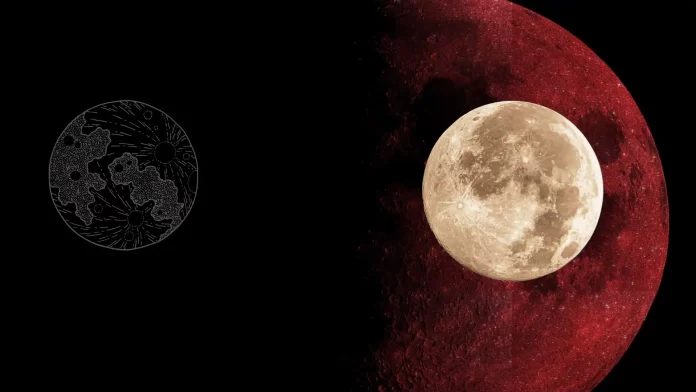Despite being so popular in our culture, that’s not a scientific name. But, in fact, that’s a thing called lunar eclipse, so use the names correctly, please.
Have you ever looked up at the night sky and seen the moon blush like it’s got a secret? Yeah, that’s a Blood Moon for you. No, it’s not some cosmic sign that vampires are having a party or werewolves are on the prowl. It’s actually a jaw-dropping spectacle that Mother Nature and celestial mechanics team up to create. A Blood Moon is what you get when a total lunar eclipse decides to show off a bit. The moon doesn’t just hide in Earth’s shadow; it turns a shade of red that can range from a soft blush to a deep crimson. So, why does this happen? And why do people, from scientists to stargazers, get so hyped about it?
The Science Behind Blood Moons
To start with, that’s not a scientific name. The right one is the lunar eclipse, but the blood moon comes to us from the Bible allusion. So, you’re telling me the moon can turn red? Yep, you heard right, and it’s not because it’s blushing. This isn’t some sci-fi flick; it’s legit science and called a Blood Moon. Now, let’s get into the details. A Blood Moon is basically the moon’s way of going incognito during a total lunar eclipse. Earth plays the middleman here, sliding right between the Sun and the Moon. And voila, Earth’s shadow, which has a lighter part called the penumbra and a darker part called the umbra, blankets the moon. But for the moon to go all rouge on us, it’s gotta be fully in that dark umbra.
But hold on, why red? Well, that’s Earth’s atmosphere. Sunlight has to pass through this atmospheric maze, and as it does, the shorter blue and violet wavelengths scatter. What’s left? The longer red and orange wavelengths. This is all thanks to Rayleigh scattering, the same dude responsible for our blue skies and those Instagram-worthy sunsets.
Now, the shade of red isn’t a one-size-fits-all deal. It can go from a soft coral to a deep, almost eerie, crimson. Factors like pollution or a recent volcanic eruption can affect the hue. The Earth’s atmosphere bends this red light towards the moon, a little trick known as atmospheric refraction.
Lunar eclipses aren’t as rare as their solar siblings, but they’re still a big deal in the sky-gazing community. Best part? You don’t need any fancy gear to watch one. Just find a spot where it’s nighttime, look up, and let the moon put on its show.
Types of Lunar Eclipses
Alright, so we’ve talked about the moon going all red-carpet-ready with Blood Moons. But did you know the moon has other wardrobe changes, too? Yep, lunar eclipses come in different flavors, each with its unique vibe.
First up, we’ve got the total lunar eclipse, the superstar of the bunch. This is when the moon dives headfirst into Earth’s umbra, the darker inner shadow. The result? A Blood Moon, which we’ve already dissected.
Next in line is the partial lunar eclipse. Think of it as the moon dipping its toes into the umbra but not fully committing. Only a portion of the moon gets that shadowy treatment, so it’s like the moon is wearing a cosmic eye patch.
Then there’s the penumbral lunar eclipse, the introvert of lunar eclipses. The moon just grazes Earth’s penumbra, the lighter outer shadow. To the naked eye, it’s super subtle. You might not notice anything different unless you’re paying attention.
And get this: there’s even a thing called a hybrid eclipse, where the moon experiences both a partial and penumbral eclipse during the same event.
So, there you have it. The moon’s not just a one-trick pony; it has a whole repertoire of performances. And each one is a celestial event worth watching.
Cultural and Historical Significance
So, we’ve geeked out on the science, but what about the stories? The moon’s been a muse for poets, a calendar for farmers, and even a tactical tool for explorers. Yep, the moon’s not just up there for show; it’s got a rich history woven into various cultures’ fabric.
Let’s start with the myths. In some cultures, a Blood Moon was seen as an omen, a sign from the gods. The ancient Mesopotamians, for instance, thought it was a warning of impending disaster. On the other hand, the Incas believed that a cosmic jaguar was attacking the moon and would howl and shake their spears at the sky to scare it away.
But not all Blood Moon stories are doom and gloom. In some Eastern traditions, it’s considered a time for reflection and spiritual growth, a celestial pause button, if you will. And when I was reading about this, I found so many “astrology” and “spiritual practices” articles. don’t believe in them; we’re talking about the cultures of the past; there’s nothing to do with your spiritual growth, really. You’re not living in ancient times.
Now, how about a historical twist? Remember Christopher Columbus? The guy who sailed the ocean blue in 1492? He used a lunar eclipse to his advantage during his fourth voyage. Stranded in Jamaica and running low on supplies, he convinced the native people to help him by predicting a lunar eclipse, thanks to his almanac.
And let’s not forget the modern interpretations. Today, Blood Moons are a photographer’s dream and a trending topic on social media. They’ve even inspired songs and movies, making them a pop-culture phenomenon.
So, whether it’s folklore or history, the moon captures our imagination like nothing else, especially when it turns red.
Viewing a Blood Moon
So you’re itching to see a Blood Moon, huh? No worries, you don’t need to be a card-carrying astronomy club member to get in on the action. Just look up! But let’s get into some specifics, shall we?
First off, location. If the moon’s up where you are, you’re golden. There is no need to jet off to some exotic locale unless you want to.
Timing? Crucial. Lunar eclipses might not be as rare as their solar cousins, but they’re not exactly popping up every weekend either. So, keep an eye on those celestial calendars and maybe set a phone reminder or two. Some die-hard fans even globe-trot to catch these bad boys.
Telescope? Nice if you’ve got one, but not a deal-breaker. Unlike that diva, the Sun, the Moon doesn’t demand special shades. Your own two eyes will do the trick.
And hey, why not turn it into a social event? Call up some pals, grab some munchies, and make a night of it. Because, let’s be real, when else do you get to say, “Hey, wanna come over and watch the moon turn red?”






